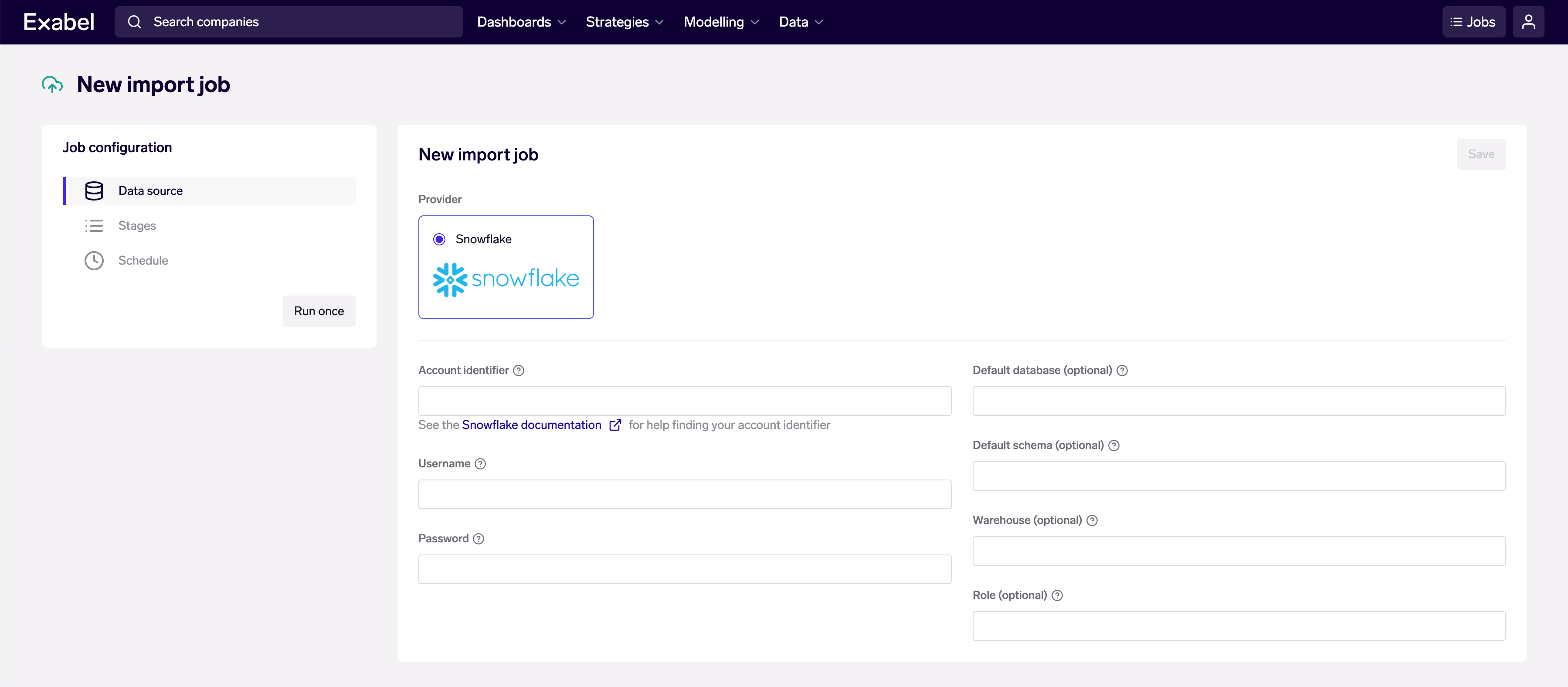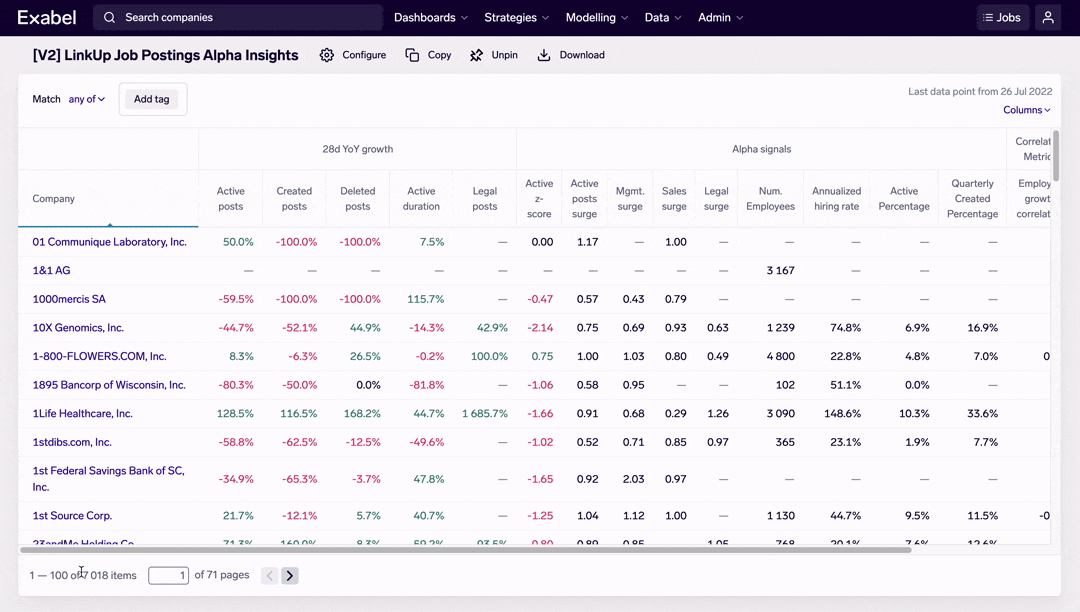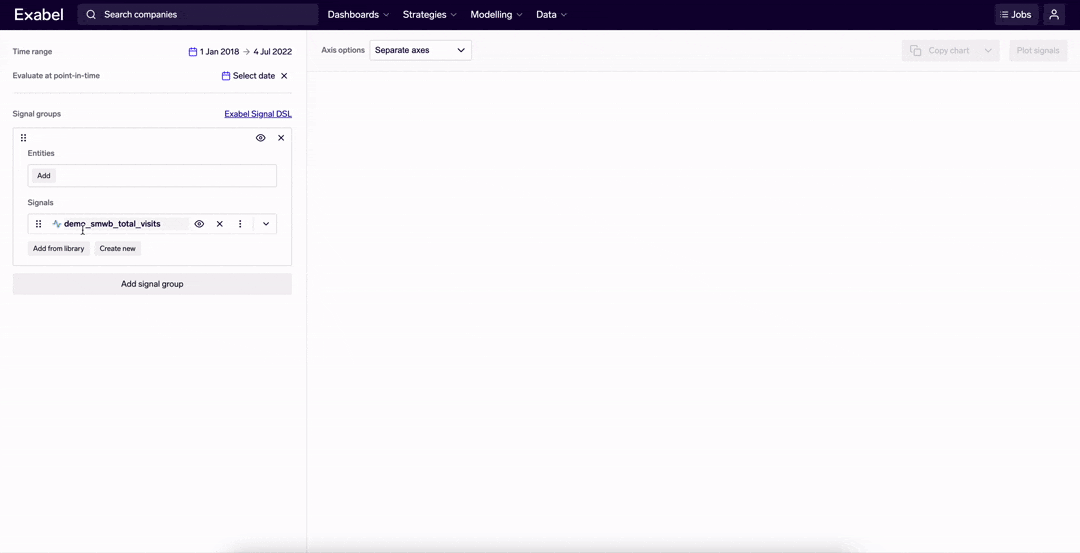July 2022 update
New Import Jobs feature for direct Snowflake integration; dashboard tables now scale to tens of thousands of rows; new Signal Explorer with re-designed user experience and support for non-company entities.
New features
Import Jobs
We launched a new Import Jobs feature, which provides a direct Snowflake integration for users to easily bring data into Exabel. This furthers our goal of helping customers analyze all their alternative data in one place, leveraging Exabel’s analytics to combine data sets and derive differentiated insights. See our user guide for more details.
 Snowflake integration via Import Jobs
Snowflake integration via Import Jobs
Dashboards
We revamped the dashboard backend and user interface to support table widgets with >500 rows, with global sorting and filtering across all rows in a table. We now support performant dashboard tables with up to 20,000 rows in the case of 1-level tables, and up to 50,000 rows in the case of 2-level tables. We have also made significant optimizations on the backend to speed up dashboard calculations and avoid bottlenecking of the system.
 Interactively sorting, filtering, and paging through a table with many rows (companies) and columns (signals)
Interactively sorting, filtering, and paging through a table with many rows (companies) and columns (signals)
Signal Explorer
We released a new version of Signal Explorer that improves upon the user experience with signal editing and plotting, adds support for selecting non-company entities, introduces "groups" that allows you to plot different sets of entities & signals, and exposes many more DSL transformations via from the signal editing interface. The correlation (scatter plot) view is still being worked on, as is a new table view of your signal data. The old version of Signal Explorer is still available.
 Revamped Signal Explorer
Revamped Signal Explorer
Other
- Foundational data: Added a new source from Factset for daily FX rates covering 51 currencies, which is broader than what was previously available through Quandl. This is now used by default in the
fx()andsignal.convert_currency()functions. You may still use the Quandl source by specifying the source parameter (reference). - Export API: New Export API accessible with your API key. For more information, see Data Export in the user guide. Please reach out to [email protected] if you would like this enabled.
- Library: Sharing will now be enabled automatically for all users, who will now be able to share a library folder to any user group that they are part of, as long as that user group only contains users from their customer. Previously, users were able to share to user groups that contained users from other customers, such as a subscriber user group managed by an Exabel data partner. As such, we had only enabled folder sharing for certain customers where this was not an issue.
- Tag editor: Revamped user interface supporting pagination through tags with many companies / entities, and improved display of exchange & sector tags for companies.
Improvements
Dashboards
- Dashboard: Exports now include column group headers and all rows (instead of only the first 500). With this, dashboard exports will now match what is displayed in the UI, making exports more intuitive and easier to use.
- Dashboards: Pop-up charts now provide the "Open chart" link to Signal Explorer, even for non-company entities.
Prediction models
- Prediction models: Support predicting up to 8 future quarters when making predictions (using the
model_by_id()DSL function) on companies without regular calendar quarters. This supports users who want to make predictions further into the future. - Prediction models: When inferring fiscal calendar frequency, so as to predict future periods, we now ignore large gaps in the underlying data. This allows the prediction of future fiscal periods to be robust to cases where users have excluded certain data points on purpose (e.g. to remove Covid effects). This fixes a reported issue with running inference on prediction models where input signals were truncated to remove Covid outliers.
DSL
- DSL: Add a new
signal.relative_change()function (reference) for cleaner & more consistent expressions. This is equivalent to the existingrelative_change(signal, ...). - DSL: Add
signal.change()function (reference) to calculate absolute change in the signal over a specified date offset. This generalizes the existing signal.yoy(), signal.qoq(), and related functions. - DSL: Add
mae()function (reference) to calculate the mean absolute error between a target and predicted signal. This is useful for users who want to export model errors, as the backtest absolute error reported in the prediction model user interface is equivalent tomae(target_signal, backtests(model_number, backtest_number)). - DSL: Add support for delta transform in the
r2_score(),wape(),regression_weight(),correlation()andcentered_correlation()functions (reference).
Other
- Move Data Explorer and the File Uploader to new
/data/...URLs within the app, for consistency amongst features dealing with raw data.
Deprecations
- Library: Remove UI editing of user-uploaded signals.
Bug fixes
- Signal Explorer: Show one axis per signal, when "Separate axes" is selected under axis options.
- Drill-downs: Fix styling in sidebar navigation.
- Dashboards: Fixed formatting of month values in columns.
- Classification models: remove NaNs as part of precomputing features, which was causing model failures with walk-forward backtesting in some cases.